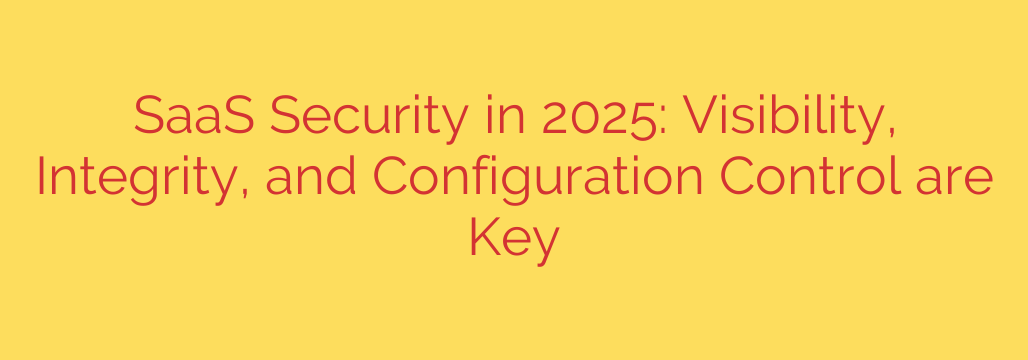
Navigating the Future of SaaS Security: Your Guide to a More Secure Cloud
The rapid adoption of Software-as-a-Service (SaaS) applications has transformed how businesses operate, offering unprecedented flexibility and collaboration. However, this explosion in cloud-based tools has also created a complex and often fragmented security landscape. As we look toward the future, maintaining control over your organization’s data requires a strategic shift. The core pillars of a modern SaaS security strategy are achieving complete visibility, ensuring platform integrity, and mastering configuration control.
Without a firm grasp on these principles, organizations are left exposed to significant risks, including data breaches, compliance violations, and unauthorized access. Let’s explore how to build a resilient security posture for the evolving world of SaaS.
The Challenge: The Unseen Risk in Your Cloud
The average organization uses hundreds of SaaS applications, many of which are adopted by individual teams without IT oversight—a phenomenon known as “shadow IT.” Each of these applications has its own set of intricate security settings, user permissions, and data-sharing capabilities.
This decentralization creates critical security blind spots. Default configurations are often permissive, prioritizing ease of use over security. This can lead to sensitive data being inadvertently exposed to the public, excessive user permissions going unchecked, and dangerous third-party app integrations creating backdoors into your environment. The fundamental challenge is simple: you cannot protect what you cannot see.
Pillar 1: Achieve Complete Visibility
The first step in securing your SaaS ecosystem is gaining a comprehensive understanding of it. True visibility goes beyond simply listing known applications. It means having a clear, real-time inventory of every SaaS tool connected to your organization, including those unauthorized “shadow IT” apps.
Effective visibility involves answering critical questions:
- Which applications are in use across the company?
- Who has access to these applications and what are their permission levels?
- What kind of data is being stored and shared within each platform?
- Which third-party applications are integrated with our core SaaS suites?
Achieving this level of insight is foundational. It allows security teams to identify redundant applications, consolidate licenses, and, most importantly, begin assessing the risk profile of their entire SaaS attack surface.
Pillar 2: Ensure Data and Configuration Integrity
Once you have visibility, the next priority is ensuring the integrity of your SaaS environments. This means actively monitoring for and preventing unauthorized or malicious changes to critical settings and data. A single, seemingly minor configuration drift—like a SharePoint site’s sharing settings being changed from “internal” to “public”—can lead to a catastrophic data leak.
Integrity monitoring is about establishing a trusted baseline for your security configurations and immediately flagging any deviations. This proactive approach helps detect potential threats early, whether they stem from a malicious actor attempting to disable security controls or an administrator making an honest mistake. By continuously verifying the state of your SaaS platforms, you can trust that your security posture remains intact.
Pillar 3: Master Configuration Control with SSPM
Visibility and integrity lay the groundwork for the most crucial pillar: active configuration control. This is the domain of SaaS Security Posture Management (SSPM), a class of tools designed to automate the monitoring and remediation of misconfigurations across your entire SaaS fleet.
Most data breaches originating in the cloud are not the fault of the SaaS provider but are due to customer-managed settings. SSPM solutions help bridge this gap by:
- Continuously scanning applications like Microsoft 365, Google Workspace, Salesforce, and Slack against established security benchmarks and compliance frameworks (e.g., CIS, NIST, SOC 2).
- Identifying risky configurations, such as public data exposure, overly permissive user roles, or insecure password policies.
- Providing guided remediation steps or even automating the correction of these issues to enforce a consistent security policy.
Mastering configuration control transforms security from a reactive, manual process into a proactive, automated, and scalable strategy.
Actionable Best Practices for a Secure SaaS Environment
To strengthen your SaaS security posture today and prepare for the future, focus on these essential security tips:
- Conduct a Full SaaS Audit: Use discovery tools to identify all applications in use, including shadow IT. Begin consolidating applications and eliminating unsanctioned tools.
- Implement the Principle of Least Privilege: Regularly review user access rights and permissions. Ensure employees only have access to the data and functions absolutely necessary for their roles. Remove excessive admin rights immediately.
- Automate Security Monitoring: Manually checking hundreds of settings across dozens of apps is impossible. Invest in an SSPM solution to automate the detection and remediation of misconfigurations.
- Vet Third-Party Integrations: Before allowing an integration with a core SaaS platform, thoroughly vet its security and data access permissions. Treat these integrations as extensions of your own attack surface.
- Develop a Consistent Security Baseline: Define a non-negotiable set of security configurations for all your critical SaaS applications and use automation to enforce it.
- Train Your Team: Educate employees on the risks of unauthorized applications and the importance of strong passwords, multi-factor authentication (MFA), and secure data-sharing practices.
Ultimately, securing your organization’s SaaS ecosystem requires moving beyond a fragmented, app-by-app approach. By focusing on the core pillars of visibility, integrity, and configuration control, you can build a comprehensive and resilient security framework that protects your most valuable data now and in the years to come.
Source: https://www.tripwire.com/state-of-security/saas-security-visibility-integrity-configuration-control








